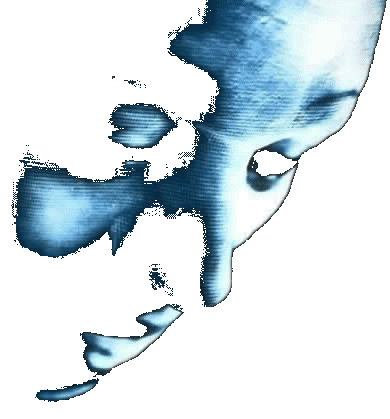
'Joanna' from 'Surfacing the Soul: a Visiognomy of Ignominy' [1996]
Where to look for how to look?
In other words, what templates of personal style exist specifically for 'the look' on your face? The body's most legible surface is simultaneously a personally and a socially acceptable expression of the otherwise invisible human psyche. Formerly perhaps 'human nature' and the conventions of first-hand social interaction were the sources for behavioural mimickry, but increasingly - as interactivity becomes more of an affair between people and screens - the individual has looked to representations as primary information. Portraiture has taken on new significance within mass media and the most abundantly repetitious [and therefore influential] of portrayals are the commercial realm's caricatures of its subjects, of consumers. In our market-society, supplementary to the exhortation from Commerce for us to be conspicuous consumers of products, facial 'looks' are also on offer: the potential conquest; the shallow sycophant; the threatening rival, to cite just a few. In face-to-face encounters with those imprinted by a similar iconography, the pout, the smirk and the scowl are appropriate and quickly recognised expressions. The consumerist spectacle has confirmed that language is mannerism, life is masque. So, watch the screen, practice in the mirror, look 'em dead in the optics, and say: 'fuck me now!'; 'have a nice day!'; ''you talkin' t' me!?' But do it visually, do it without words. That's face.
In other words, what templates of personal style exist specifically for 'the look' on your face? The body's most legible surface is simultaneously a personally and a socially acceptable expression of the otherwise invisible human psyche. Formerly perhaps 'human nature' and the conventions of first-hand social interaction were the sources for behavioural mimickry, but increasingly - as interactivity becomes more of an affair between people and screens - the individual has looked to representations as primary information. Portraiture has taken on new significance within mass media and the most abundantly repetitious [and therefore influential] of portrayals are the commercial realm's caricatures of its subjects, of consumers. In our market-society, supplementary to the exhortation from Commerce for us to be conspicuous consumers of products, facial 'looks' are also on offer: the potential conquest; the shallow sycophant; the threatening rival, to cite just a few. In face-to-face encounters with those imprinted by a similar iconography, the pout, the smirk and the scowl are appropriate and quickly recognised expressions. The consumerist spectacle has confirmed that language is mannerism, life is masque. So, watch the screen, practice in the mirror, look 'em dead in the optics, and say: 'fuck me now!'; 'have a nice day!'; ''you talkin' t' me!?' But do it visually, do it without words. That's face.